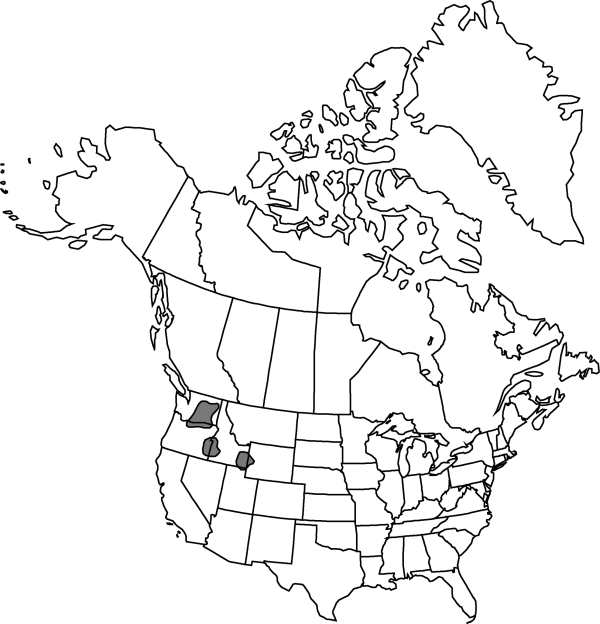Difference between revisions of "Abronia mellifera"
Bot. Mag. 56: plate 2879. 1829.
FNA>Volume Importer |
FNA>Volume Importer |
||
| Line 16: | Line 16: | ||
}}<!-- | }}<!-- | ||
| − | --><span class="statement" id="st- | + | --><span class="statement" id="st-undefined" data-properties=""><b>Plants </b>perennial. <b>Stems</b> decumbent to ascending, much branched, elongate, glabrous or glandular-pubescent. <b>Leaves</b>: petiole 1–6 cm; blade ovate to lance-elliptic, 1–6 × 0.5–4 cm, margins entire to sinuate and ± undulate, surfaces glabrous or glandular-pubescent. <b>Inflorescences</b>: peduncle longer than subtending petiole; bracts lanceolate to obovate, 5–12 × 1–5 mm, papery, glabrate to glandular-pubescent; flowers 25–60. <b>Perianth</b>: tube pale rose proximally to greenish distally, 15–25 mm, limb white, 7–12 mm diam. <b>Fruits</b> winged, broadly obdeltate or cordate in profile, 6–10 × 4–10 mm, thin, usually coriaceous, rarely indurate, base attenuate, apex prominently beaked; wings (2–)5 (when 2, folded to form single deep groove), without dilations, broad, thin, without cavities.</span><!-- |
-->{{Treatment/Body | -->{{Treatment/Body | ||
| + | |phenology=Flowering spring–fall. | ||
|habitat=Sandy soils, cold desert scrub, grasslands | |habitat=Sandy soils, cold desert scrub, grasslands | ||
|elevation=100-2000 m | |elevation=100-2000 m | ||
| Line 37: | Line 38: | ||
|basionyms= | |basionyms= | ||
|family=Nyctaginaceae | |family=Nyctaginaceae | ||
| + | |phenology=Flowering spring–fall. | ||
|habitat=Sandy soils, cold desert scrub, grasslands | |habitat=Sandy soils, cold desert scrub, grasslands | ||
|elevation=100-2000 m | |elevation=100-2000 m | ||
| Line 44: | Line 46: | ||
|publication year=1829 | |publication year=1829 | ||
|special status= | |special status= | ||
| − | |source xml=https://jpend@bitbucket.org/aafc-mbb/fna- | + | |source xml=https://jpend@bitbucket.org/aafc-mbb/fna-data-curation.git/src/9216fc802291cd3df363fd52122300479582ede7/coarse_grained_fna_xml/V4/V4_127.xml |
|genus=Abronia | |genus=Abronia | ||
|species=Abronia mellifera | |species=Abronia mellifera | ||
| − | |||
| − | |||
| − | |||
| − | |||
| − | |||
| − | |||
| − | |||
| − | |||
| − | |||
| − | |||
| − | |||
| − | |||
| − | |||
| − | |||
| − | |||
| − | |||
| − | |||
| − | |||
| − | |||
| − | |||
| − | |||
| − | |||
| − | |||
| − | |||
| − | |||
| − | |||
| − | |||
| − | |||
| − | |||
| − | |||
| − | |||
| − | |||
}}<!-- | }}<!-- | ||
-->[[Category:Treatment]][[Category:Abronia]] | -->[[Category:Treatment]][[Category:Abronia]] | ||
Revision as of 13:56, 27 July 2019
Plants perennial. Stems decumbent to ascending, much branched, elongate, glabrous or glandular-pubescent. Leaves: petiole 1–6 cm; blade ovate to lance-elliptic, 1–6 × 0.5–4 cm, margins entire to sinuate and ± undulate, surfaces glabrous or glandular-pubescent. Inflorescences: peduncle longer than subtending petiole; bracts lanceolate to obovate, 5–12 × 1–5 mm, papery, glabrate to glandular-pubescent; flowers 25–60. Perianth: tube pale rose proximally to greenish distally, 15–25 mm, limb white, 7–12 mm diam. Fruits winged, broadly obdeltate or cordate in profile, 6–10 × 4–10 mm, thin, usually coriaceous, rarely indurate, base attenuate, apex prominently beaked; wings (2–)5 (when 2, folded to form single deep groove), without dilations, broad, thin, without cavities.
Phenology: Flowering spring–fall.
Habitat: Sandy soils, cold desert scrub, grasslands
Elevation: 100-2000 m
Distribution

Idaho, Oreg., Utah, Wash., Wyo.
Discussion
Selected References
None.